The Siena experience
One of the places I’ve wanted to visit for quite some time is Siena. And yesterday, when I finally got there, I wasn’t disappointed.
One of the nicest things about the city is the fact that its hilltop location can now be reached from parking lots by a series of escalators that make it possible for less-than-tough tourists to get there and begin walking around without having exhausted themselves climbing the hill before they even begin. The inside of the town itself is hilly enough to constitute a workout walking around and seeing the sights, which are considerable.
It was hot, as Tuscany has been the whole time I’ve been here. But it was shady for the most part, and the city that is rightly called “medieval” is astounding. Everywhere you look it seems as though you’ve stepped into a many-centuries’ old set of some sort, except this set is real. And the colors of the buildings (and their interiors) make you understand why the old 64-crayon crayola box had a crayon called “burnt sienna,” a sort of dark terra-cotta.
I’m not especially into medieval art or church art, but it’s impossible to be in Siena and not be in awe of both. Its big cathedral is the sort of place you enter and immediately think “Wow!”—which isn’t very articulate but certainly expresses the overwhelming nature of the ornate and yet never-too-busy harmony of its decorative abundance.
I have never been so fascinated by a floor, and that’s quite a feat considering how much else of beauty there is to see in this cathedral. But the floor, the floor!:
The inlaid marble mosaic floor is one of the most ornate of its kind in Italy, covering the whole floor of the cathedral. This undertaking went on from the 14th to the 16th centuries, and about forty artists made their contribution. The floor consists of 56 panels in different sizes. Most have a rectangular shape, but the later ones in the transept are hexagons or rhombuses. They represent the sibyls, scenes from the Old Testament, allegories and virtues. Most are still in their original state. The earliest scenes were made by a graffito technique: drilling tiny holes and scratching lines in the marble and filling these with bitumen or mineral pitch. In a later stage black, white, green, red and blue marble intarsia were used. This technique of marble inlay also evolved during the years, finally resulting in a vigorous contrast of light and dark, giving it an almost modern, impressionistic composition.
It was all that, and more. In addition (and something I hadn’t realized), I was highly fortunate in that the floor is only uncovered during a couple of months of the year. I happened to have visited during that time:
Siena Duomo floor uncovering 2018 dates: June 27 to July 31, 2018, and then again from August 18 to October 28, 2018.
That site I just linked has a lot more information on the floor.
And the ceilings are no slouch, either. So without further ado, here are a couple of photos I took of floor, ceiling, and in-between, as well as the ceilings of the old hospital building in Siena. It’s probably not like any hospital you’ve ever seen:

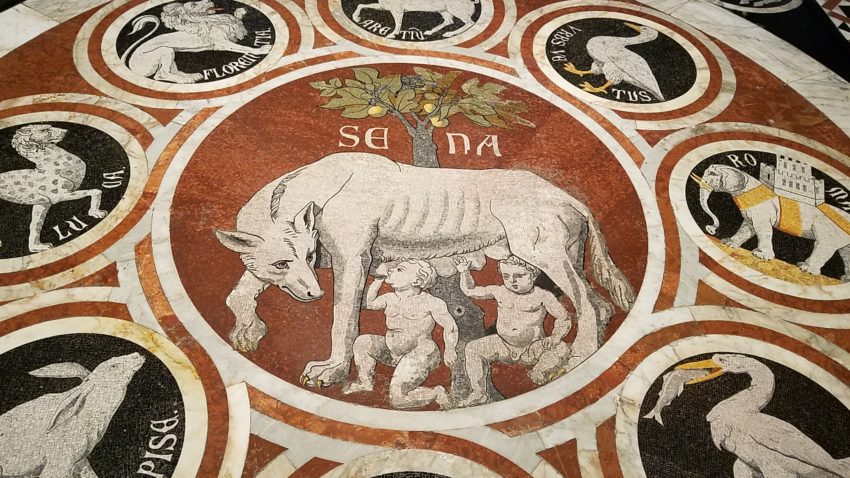
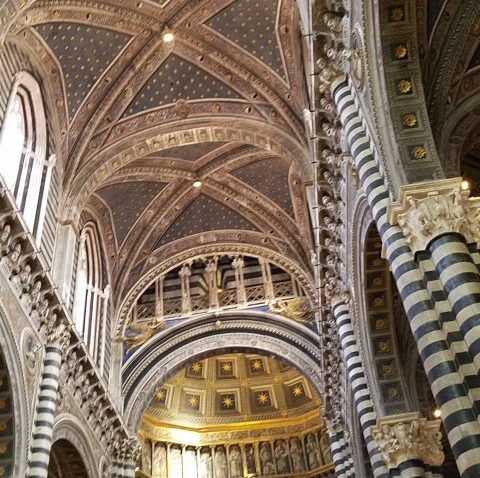
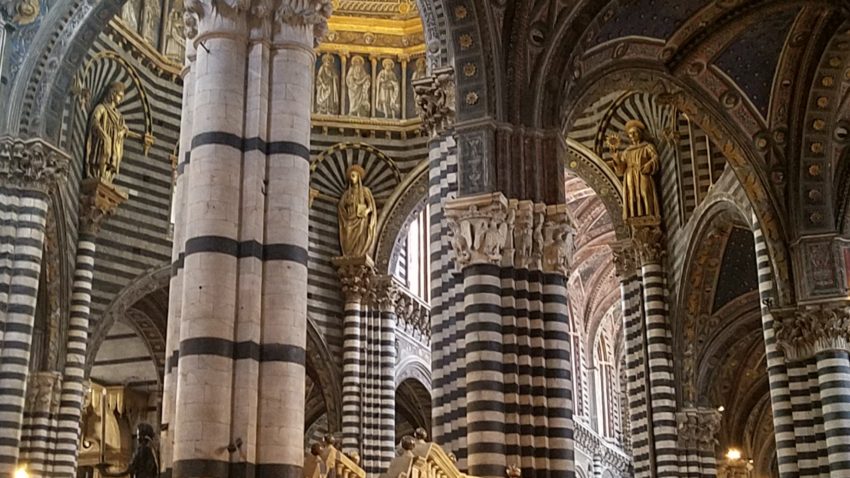
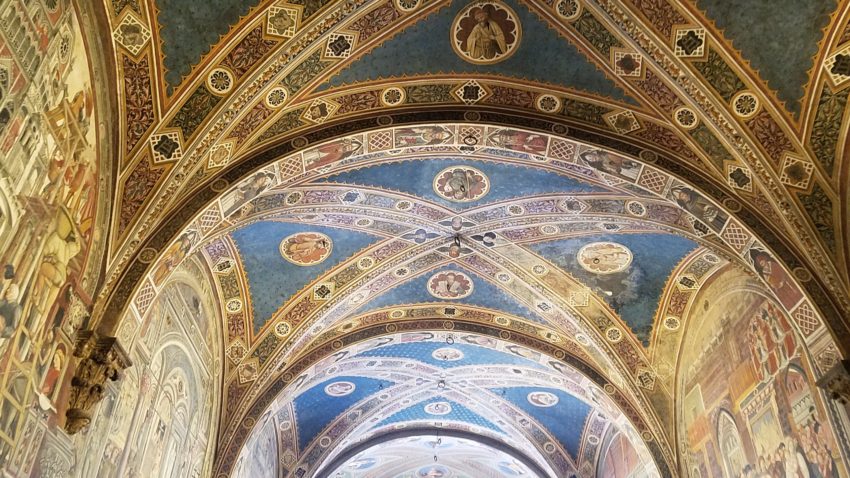
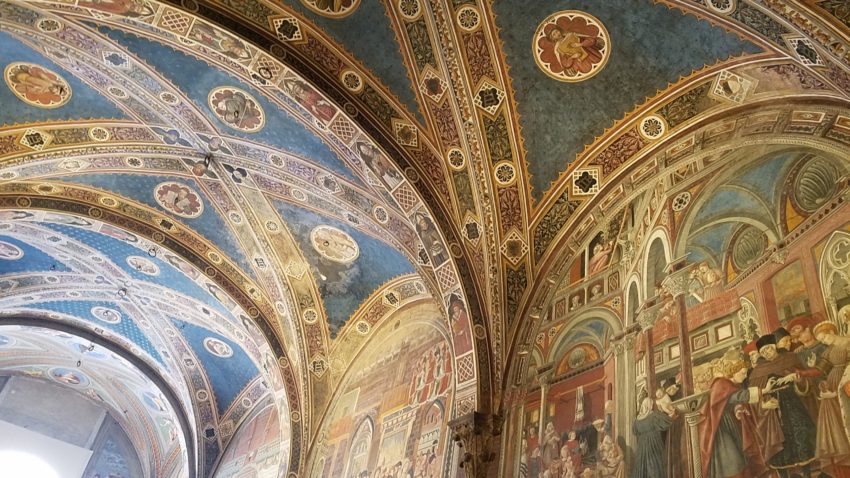
Most extraordinary. I’m wagering the small corps of art historians who are period specialists and have regular salaries think they’ve got the best job in the world. And they do.
Still waiting to hear your tribute to Eydie Gorme.
Across the street from the cathedral is a place that was once a hospital. It has magnificent frescos, one of which depicts the fate of babies in that era.
I took that photo on a trip and it shows the babies rising to Heaven and the Madonna welcoming them.
There are other frescos showing the treatment of wounds. It was used as a hospital until quite recently.
The plaques marking the neighborhoods of the klans are also interesting.
Neo,
Your “Wow!” response is exactly what was intended.
The impetus behind the creation of such structures was to serve as a visual metaphor of divine presence. One is supposed to be acutely aware that they have entered a special place divorced from the reality outside. That your experience in 2018 undoubtedly duplicates the experience of innumerable visitors for the past 800 years is a testament to the effectiveness of that medieval vision and its execution.
Also, JIC you aren’t aware, the Piazza del Campo and the Torre del Mangia gave Niall Ferguson the idea for his book title ‘The Square and the Tower’.
Mike K:
That’s what I meant towards the end there, the building I called the “old hospital.” The bottommost photo is of some of the ceiling and one of the frescoes in that building. It’s of part of the same series, in this case depicting the children on the left, and the wet nurses on the right.
I remember walking down that rabbit warren of cobblestone streets in the old city on my way to the University of Siena. I turned a corner and saw a number of open front spaces where craftsmen and artisans were working. There were men forging iron over open fires and it looked for all the world like I had entered a time warp into the Middle Ages. It’s something I’ll never forget.
How glorious was Europe. How fortunate that we have a pictorial record of what once was… “After 1,700 years, Buddhas fall to Taliban dynamite”
Happened to be chaperoning a bunch of kids to a mountain town in Spain during Holy Week. The kids and the other chaperones dispersed in various directions while I had my role as “home base”. Anything happens, find Aubrey. He’ll be….here. Happened to be in front of an ancient cathedral.
In the plaza outside were tables where people in evening dress were reading from large sheets and waving their arms around. I was wondering about whether I should have quit drinking for the duration.
Then they went into the cathedral
Turns out they were soloists.
And there I was in the warm sun and cool air of mountain Castile, listening to a medieval Mass.
Afraid to close my eyes in case eight or nine centuries might disappear.
I’m wondering how many other people first found out about Siena while reading Herman Wouk’s masterful book “The Winds of War”?
That was certainly true in my case.
For the first moment, Neo, I forgot you were in Italy and, seeing the headline of the post, I thought this was going to be about your visit to Siena College up my way.
A real treat. My trips to Europe have mostly been to the mountainous areas. Churches are everywhere, but most in the mountains are quite simple. They’re representative of the relatively less prosperous mountain economies. So, I’ve seen few of the more magnificent churches that exist in Europe. Thus, this is a wonderful treat to see your pictures.
I’ve never been, though I’ve been to others and the scale, the colors and artistry, and the craftsmanship is wonderful. I was always struck by the magnificance of the alternating colors of the layers of stone and brick in these huge churches. It makes a very powerful visual statement.
Great photos. And they are yours to use as and when you see fit.